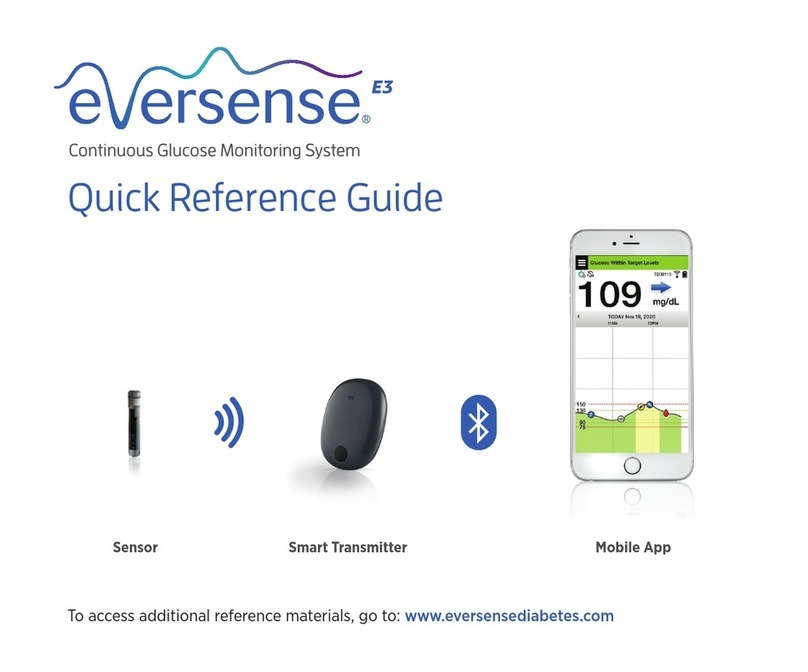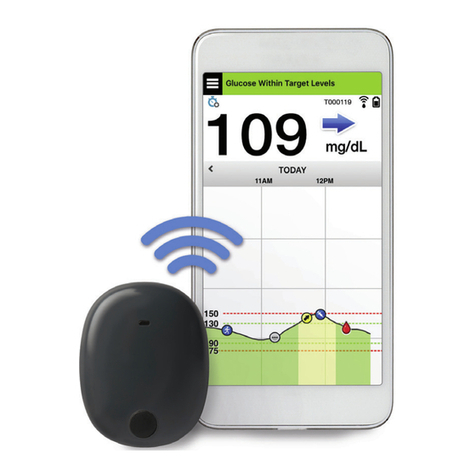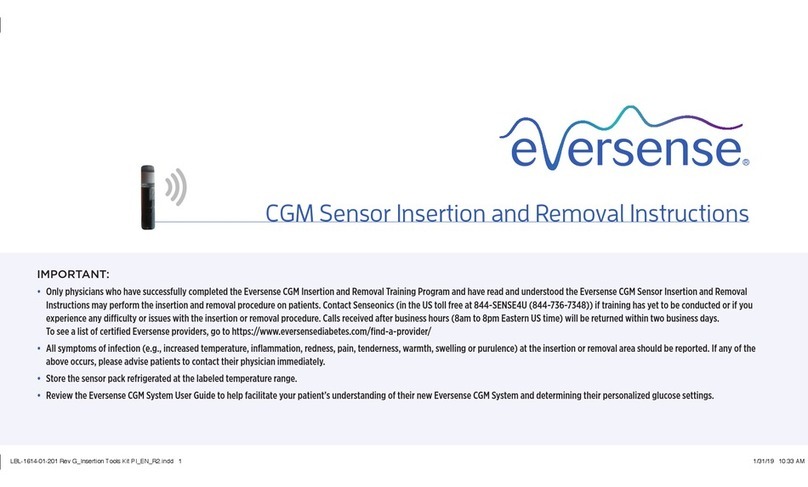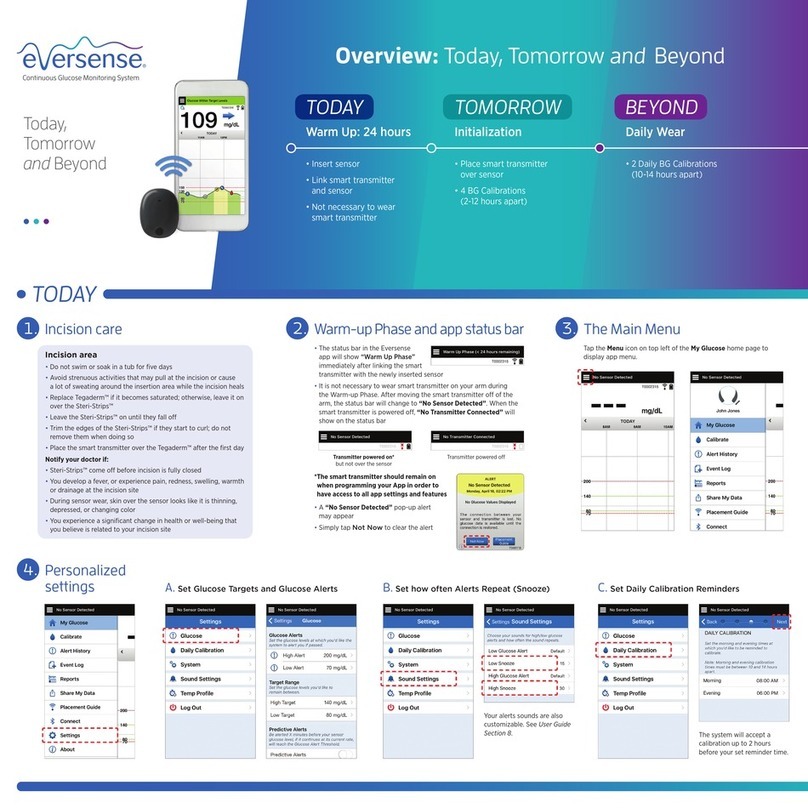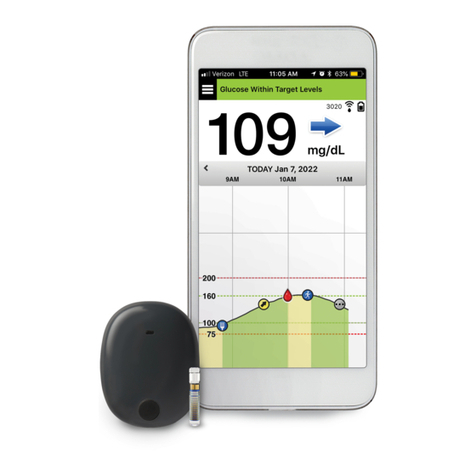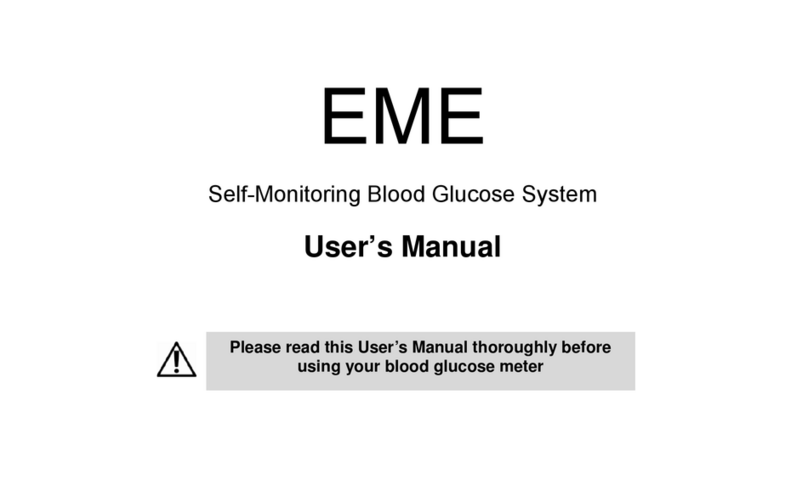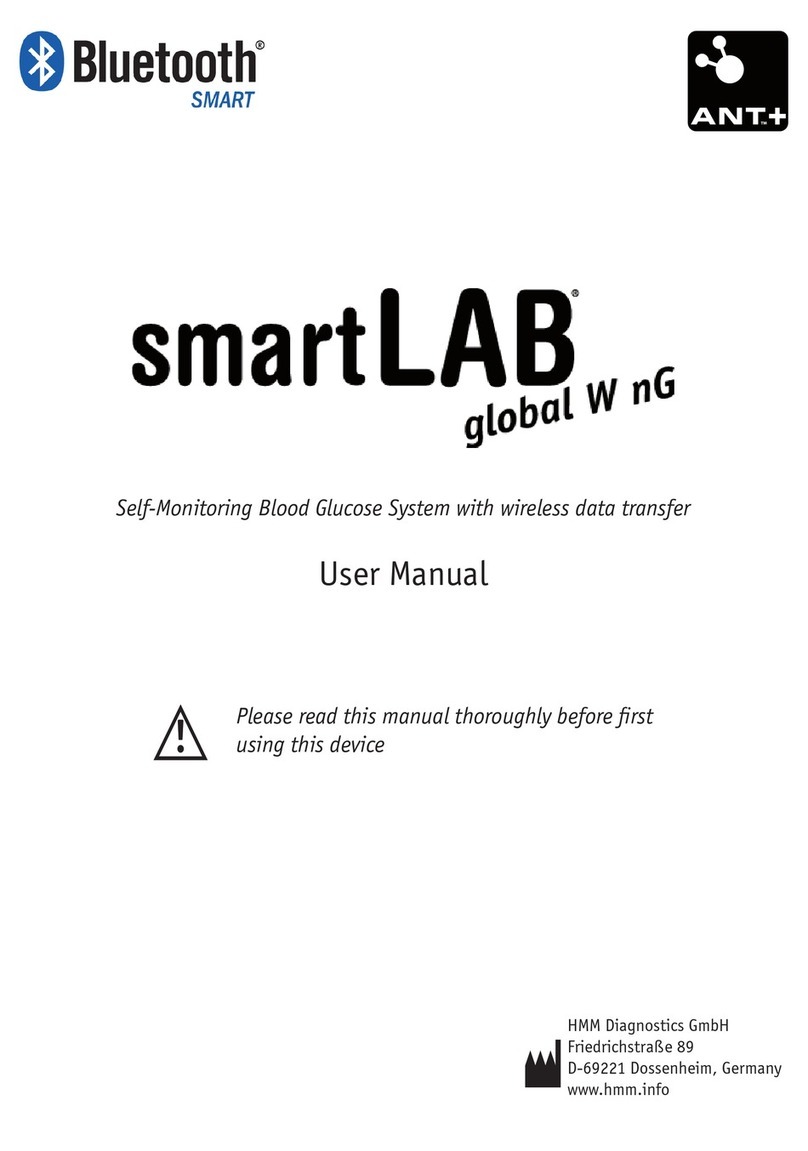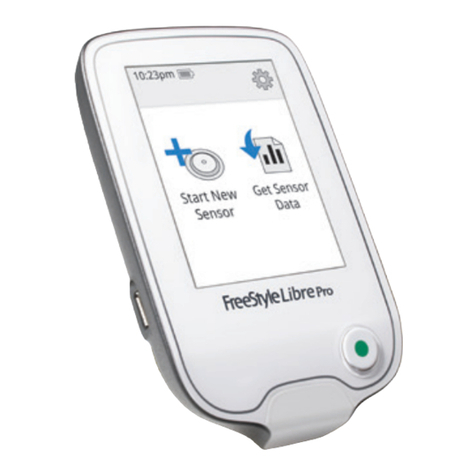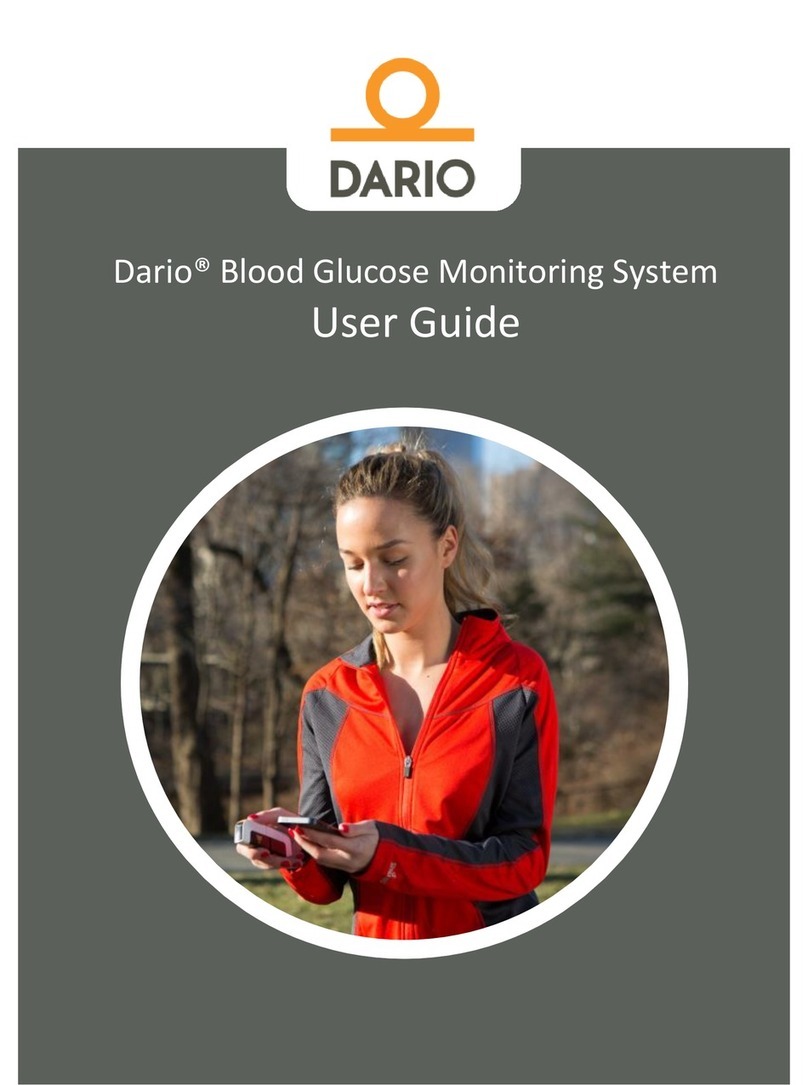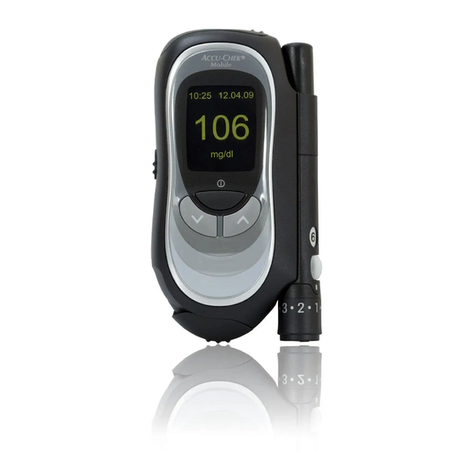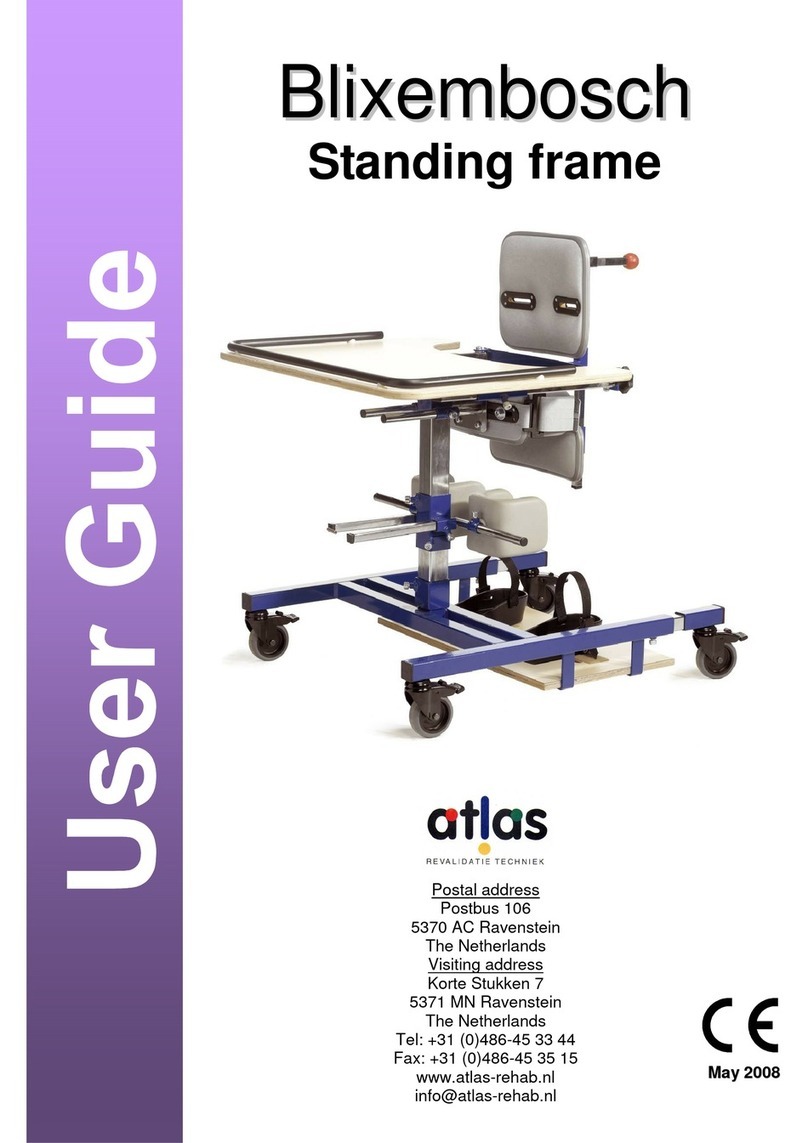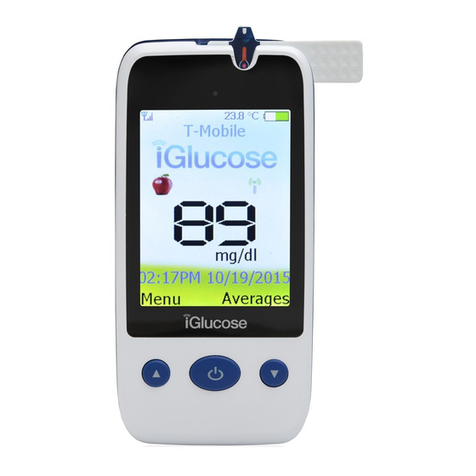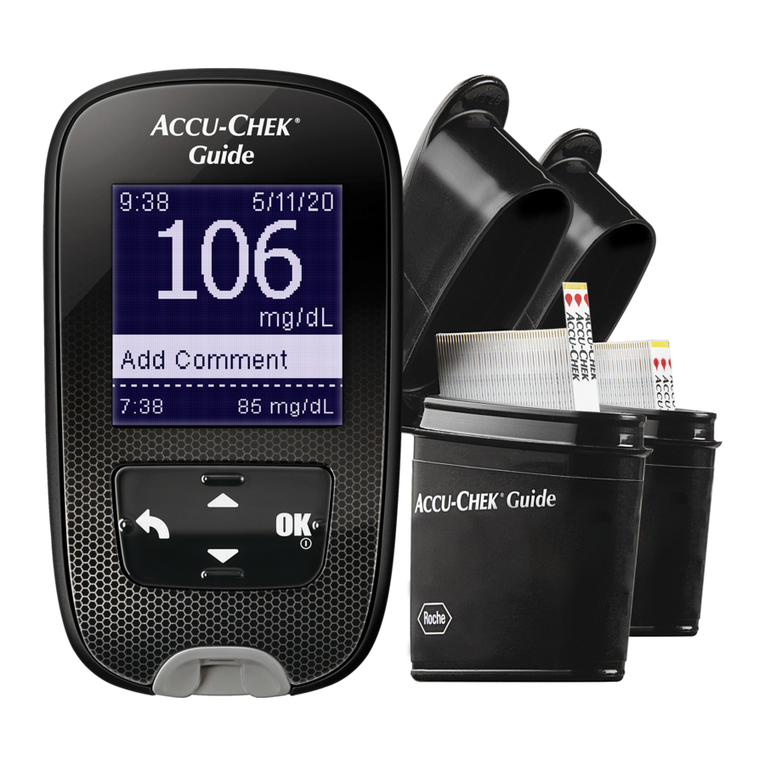eversense XL User manual

CGM Sensor Insertion and Removal Instructions
Pokyny pro zavedení avyjmutí senzoru pro kontinuální sledování
hladiny glukózy
Instrucciones de inserción y extracción del sensor de MCG
Instrukcja wszczepiania i usuwania czujnika CGM


3
Eversense XL CGM Sensor Insertion and Removal Instructions
Contents | Obsah | Contenido | Spis treści
British English CGM Sensor Insertion and Removal Instructions ............................................................ 5
Čeština Pokyny pro zavedení a vyjmutí senzoru pro kontinuální
sledování hladiny glukózy ............................................................................................... 45
Español Instrucciones de inserción y extracción del sensor de MCG ........................................85
Polskie Instrukcja wszczepiania i usuwania czujnika CGM ......................................................125

4Eversense XL CGM Sensor Insertion and Removal Instructions

CGM Sensor Insertion and Removal Instructions
IMPORTANT:
• Only GPs who have successfully completed the Eversense XL CGM Insertion and Removal Training Programme and have read and understood the Eversense XL CGM Sensor Insertion and Removal
Instructions may perform the insertion and removal procedure on patients. For more information on local distributors, please see the back cover.
• All symptoms of infection (e.g. increased temperature, inflammation, redness, pain, tenderness, warmth, swelling or purulence) at the insertion or removal area should be reported. If any of the
above occurs, please advise patients to contact their GP immediately.
• Store the sensor pack refrigerated at the labelled temperature range.


7
Eversense XL CGM Sensor Insertion and Removal Instructions
1. Overview of the Eversense XL Continuous Glucose Monitoring
(CGM) System
Congratulations on having the latest diabetes technology from Senseonics to assist your patients in managing their diabetes. The Eversense XL CGM System is for people with diabetes to continually
measure glucose levels for the operating life of the sensor.
Some of the features of the Eversense XL CGM System:
• Wireless communication with the sensor, smart transmitter and app.
• Long-term sensor wear in the upper arm for the operating life of the sensor.
• Alerts when pre-set Low or High Glucose Alert levels (hypoglycaemia or hyperglycaemia) are reached.
• Predictive alerts to alert the patient before reaching pre-set Low or High Glucose Alert levels.
• Use of mobile device (e.g., smartphone) to display glucose readings.
• On-body vibe alerts with the smart transmitter even when mobile device is not nearby.
• Provides readings within 2.2 – 22.2 mmol/L (40 – 400 mg/dL) range every 5 minutes.
• Trend arrows that show whether glucose values are rising or falling and how fast.
• Graphs and statistics that show glucose results in easy-to-understand formats.
• Removable and rechargeable smart transmitter.
• Event entry capabilities (like meals, exercise and insulin).
• Stores glucose data in the app and on the smart transmitter.

8Eversense XL CGM Sensor Insertion and Removal Instructions
Eversense XL CGM System Components
The System includes:
1) a small sensor inserted subcutaneously by a GP,
2) a removable smart transmitter worn over the sensor, and
3) a mobile app to display the glucose readings.
Eversense XL Sensor
The sensor is inserted under the skin (upper arm) and measures glucose in interstitial fluid. These glucose levels are then calculated by the smart
transmitter and sent to the app.
The Eversense XL Sensor lasts up to 180 days. The sensor has a silicone ring that contains a small amount of dexamethasone acetate, an anti-inflammatory
steroid drug. The dexamethasone acetate minimises inflammatory responses, very similar to common medical devices, such as pacemakers.
Specially designed sensor insertion tools are provided for subcutaneous insertion of the senso r. Other equipment necessary for the procedure, but not
included in the Eversense XL Insertion Tool Pack, is listed in Section 4.
Eversense XL Smart Transmitter
The removable smart transmitter is worn externally over the sensor and powers the sensor. It wirelessly sends glucose data (via Bluetooth) to the mobile
device app. The smart transmitter also provides on-body vibe alerts based on the pre-set glucose level settings. It has a rechargeable battery and is
reusable for up to one year. Adhesive patches included with the Eversense XL Insertion Tools Pack are provided for the patient to replace daily.
Eversense App
The Eversense App is a software application that runs on a mobile device (e.g., smartphone) and displays glucose data in a variety of ways. It also provides
alerts based on the pre-set glucose level settings.
Sensor
Smart Transmitter Eversense App
Note: Not actual size

9
Eversense XL CGM Sensor Insertion and Removal Instructions
Continuous glucose monitoring aids in the management of diabetes and glucose control, which can improve your patient’s quality of life. Best results are achieved when you are fully informed about the
risks and benefits, insertion procedure, follow-up requirements, and self-care responsibilities. You should not have the sensor inserted if you cannot properly operate the CGM System.
The CGM System measures glucose in interstitial fluid (ISF) between the body’s cells. Physiologic dierences between ISF and blood from a fingerstick may result in dierences in glucose measurements. These
dierences are especially evident during times of rapid change in blood glucose (e.g., after eating, dosing insulin, or exercising). Glucose levels in ISF lag behind glucose levels in blood by several minutes.
The sensor has a silicone ring that contains a small amount of an anti-inflammatory drug (dexamethasone acetate). It has not been determined whether the risks associated with injectable dexamethasone
acetate apply to the dexamethasone acetate elution ring inside the sensor. The elution ring releases a small amount of dexamethasone acetate when the sensor comes in contact with body fluids and serves
to minimise the body’s inflammatory response to the inserted sensor. Dexamethasone acetate in the ring may also cause other adverse events not previously seen with the injectable form.
Indications for Use
The Eversense XL CGM System is indicated for continually measuring interstitial fluid glucose levels in adults (18 years and older) with diabetes for the operating life of the sensor.
The system is intended to:
• Aid in the management of diabetes.
• Provide real-time glucose readings.
• Provide glucose trend information.
• Provide alerts for the detection and prediction of episodes of low blood glucose (hypoglycaemia) and high blood glucose (hyperglycaemia).
Historical data from the system can be interpreted to aid in providing therapy adjustments. These adjustments should be based on patterns and trends seen over time.
The system is indicated for use as an adjunctive device to complement, not replace, information obtained from standard home blood glucose monitoring devices.
2. Benets and Risks

10 Eversense XL CGM Sensor Insertion and Removal Instructions
Contraindications
• The system is contraindicated in people for whom dexamethasone or dexamethasone acetate may be contraindicated.
• The sensor and smart transmitter are incompatible with magnetic resonance imaging (MRI) procedures. Patients should not undergo an MRI procedure while the sensor is inserted or when wearing the
smart transmitter. Should an MRI be required the sensor must be removed before the procedure.
• Mannitol or sorbitol, when administered intravenously, or as a component of an irrigation solution or peritoneal dialysis solution, may increase blood mannitol or sorbitol concentrations and cause falsely
elevated readings of your sensor glucose results. Sorbitol is used in some artificial sweeteners, and concentration levels from typical dietary intake do not impact sensor glucose results.
Risks and Side Eects
The glucose alerts and notifications will not audibly notify the user when the sound on the user’s mobile device is turned o. If the system cannot display a glucose value, it also cannot provide glucose
alerts. If the patient is unable to feel the vi bration of the smart transmitter he/she may not notice the alerts. The system’s calculated glucose can be slightly dierent from a blood glucose meter. This may
cause an alert to activate at a dierent time than they would have if the system’s values always matched the blood glucose meter values. If the patient does not take frequent blood glucose measurements
and misses an alert, he/she may not be aware of high or low glucose levels. Medical attention may be needed in the event that he/she has high or low glucose and is unaware of it. If the patient does not
test their glucose with a blood glucose meter when symptoms of a low or high blood glucose level appear OR when symptoms are not consistent with the sensor glucose readings, he/she may miss a high
or low glucose event. If a patient does not always test glucose with a blood glucose meter before making a treatment decision, he/she may inadvertently cause a high or low blood glucose value because
actual glucose values can be slightly dierent than the system’s displayed values.
The sensor is inserted by making a small incision and placing it under the skin. This process may cause infection, pain or skin irritation. Additionally, the adhesive may cause a reaction or skin irritation.

11
Eversense XL CGM Sensor Insertion and Removal Instructions
Warnings
• The Eversense CGM System has not been tested using insertion sites other than the upper arm.
• Patients should always test glucose with a blood glucose meter before making a treatment decision. Using the sensor glucose value to make a treatment decision could result in a high or low
blood glucose.
• If at any time there are symptoms of a low or high glucose level OR if patient symptoms are not consistent with the sensor glucose readings, patients should test glucose levels with a blood
glucose meter.
• Patients should not use a smart transmitter if it is damaged or cracked as this could result in electrical shock.
• Patients should avoid close contact with electromagnetic interference (EMI) while wearing the smart transmitter.
• Tetracyclines may falsely lower sensor glucose readings. Patients should always test their glucose with their blood glucose meter if they are taking tetracyclines.
• Until it has healed, always cover the insertion site with a sterile bandage before placing the smart transmitter adhesive over the sensor. Failure to do so could result in infection at the insertion site.
• The system should only be calibrated using a fingerstick blood sample. Alternative sites (such as forearm or palm) should not be used to calibrate the system.
• Infusion sets for insulin pumps should not be inserted within 10.16 cm (4 in) of the sensor site. If the insulin delivery site is within 10.16 cm (4in) of the sensor site, it may interfere with sensor
glucose readings and can cause inaccurate glucose readings.

12 Eversense XL CGM Sensor Insertion and Removal Instructions
Cautions
• The sensor and sensor holder are sterile in the unopened, undamaged, sterile package. The sensor should not be used if the sterile package has been opened or damaged.
• The sensor should not be inserted if it has been dropped from a height greater than 30 cm.
• Use only the insertion tools provided in the insertion tool kit to insert the sensor. Other insertion tools may damage the sensor.
• Instruct patients to notify airport security personnel of the presence of the device when going through the security system.
• The smart transmitter is intended to be single-patient use only. Patients should not exchange smart transmitters with another person. Each smart transmitter can be linked to only one sensor at a time.
• The following medical therapies or procedures may cause permanent damage to the sensor particularly if used in close proximity to the device:
–Lithotripsy – The use of lithotripsy is not recommended for people who have an inserted sensor because the eects are unknown.
–Diathermy – DO NOT use diathermy on people who have an inserted sensor. Energy from the diathermy can transfer through the sensor andcause tissue damage in the insertion area.
–Electrocautery – The use of electrocautery near the inserted sensor may damage the device. DO NOT use electrocautery near the sensor.
• Patients should not wear the smart transmitter during medical x-rays or computed tomography (CT) scans. To avoid interference with results, patients should remove the smart transmitter before
undergoing medical x-ray or CT scans. Patients should advise healthcare professionals about their transmitter before undergoing these tests.
• The sensor and smart transmitter should be linked the day of insertion. Failure to link the sensor and smart transmitter could result in a delay in receiving glucose readings.
• Steroid use – It has not been determined whether the risks usually associated with injectable dexamethasone acetate apply to the use of this dexamethasone acetate elution ring, a highly
localised, controlled-release device. The dexamethasone acetate ring could cause other adverse events not listed or previously seen.
• If the sensor, insertion site or smart transmitter feel warm, the patient should remove the smart transmitter immediately and contact a GP for advice. A warm sensor could mean there is an
infection or a sensor malfunction.

13
Eversense XL CGM Sensor Insertion and Removal Instructions
Cautions (continued)
• Patients should remove the smart transmitter from their arm before charging the smart transmitter battery. Failure to remove the smart transmitter while it is charging could result in electrical shock.
• Patients should not attempt to use the Eversense App while operating a motor vehicle.
• Patients should not receive massage therapy near the inserted sensor site. Massage therapy near the sensor site could cause discomfort or skin irritation.
• Patients should only use the AC power adapter and USB cable provided with the smart transmitter when charging the smart transmitter battery. Use of another power supply could damage the
smart transmitter, not allowing glucose readings to be received properly, and could result in voiding the warranty.
• Patients with concerns about allergic reaction to silicones should contact their GP. The adhesive patch should be discarded after 24hours of use.
• The Eversense NOW Remote Monitoring App does not replace the monitoring regimen as directed by the healthcare professionals.
• The Eversense XL CGM System has not been tested in the following populations: women who are pregnant or nursing, people under the age of 18, critically ill or hospitalised patients, people
receiving immunosuppressant therapy, chemotherapy or anti-coagulant therapy, those with another active implantable device, e.g., an implantable defibrillator (passive implants are allowed,
e.g., cardiac stents), those with known allergies to or using systemic glucocorticoids (excluding topical, optical or nasal, but including inhaled).

14 Eversense XL CGM Sensor Insertion and Removal Instructions
3. Eversense XL CGM System Candidates and Pre-Insertion Activities
Candidate Selection
Per ACE/AACE guidelines*, potential candidates for CGM include those patients:
• Taking insulin to treat their T1 or T2 diabetes, and motivated to optimise their blood glucose management with the addition of new glucose monitoring technology.
• Able to follow device labeling and use their blood glucose meter results to make treatment decisions.
• Have hypoglycaemic unawareness/frequent hypoglycaemia.
• With their haemoglobin A1c (HbA1c) over target, or with excess glycaemic variability – requiring HbA1c lowering without increased hypoglycaemia.
Eversense XL CGM System Candidates
• Must have a compatible Android or IOS device, be familiar with its functionality and have WiFi connectivity.
• Not planning on having an MRI while the sensor is inserted.
• Willing to enter a calibration blood glucose (BG) into the app twice a day.
• Discuss appropriate placement of sensor insertion and smart transmitter wear.
• No known contraindication to dexamethasone acetate.
• Is not receiving mannitol or sorbitol, administered intravenously, or as a component of an irrigation solution or peritoneal dialysis solution, as this may increase blood mannitol or sorbitol concentrations
and cause falsely elevated readings of sensor glucose results. Sorbitol is used in some artificial sweeteners, and concentration levels from typical dietary intake do not impact sensor glucose results.
• Is not pregnant or under the age of 18.
* Blevins T, Bode B, Garg S, Grunberger G, Hirsch I, Jovanovic L, et al. Statement by the American Association of Clinical Endocrinologists Consensus Panel on Continuous Glucose Monitoring. Endocrine
Practice, 2010; 16(5): A.

15
Eversense XL CGM Sensor Insertion and Removal Instructions
Pre-Insertion Training Activities for Patient
• Download Eversense App to compatible mobile device (requirements are listed in User Guide) and become familiar with functionality.
• Discuss the importance of setting the correct “Unit of Measure” in the Eversense App.
• Go to www.eversensediabetes.com – view animation video, download Quick Reference Guide (QRG) and/or User Guide for review.
To pair Smart Transmitter with Compatible Mobile Device
• Charge smart transmitter for 15 minutes
• Pair smart transmitter to mobile device.
• Set system preferences according to GP recommendations.
• Instruct patients to bring smart transmitter and mobile device to clinic if it was shipped to patient’s home.

16 Eversense XL CGM Sensor Insertion and Removal Instructions
The Eversense XL CGM System Kit comes in three packages: 1) Sensor Pack, 2) Insertion Tools Pack, and the 3) Smart Transmitter Pack.
IMPORTANT: The Sensor Pack and Insertion Tools Pack contain components that are packaged sterile. Both packs are designed for single patient-use only. DO NOT re-use, re-process or re-sterilise
the sensor, blunt dissector, or insertion tool.
Items Not Included: Other procedure instruments, tools and equipment are not included and must be provided by the clinic.
4. Eversense XL CGM System Kit
1. Eversense XL Sensor Pack (Sensor in holder)
The Sensor is shipped sterile inside a protective holder for safe handling purposes. You will need to transfer the sensor to the insertion tool before use.
The sensor is approximately 3.5 mm x 18.3 mm and is subcutaneously inserted using the insertion tool. The sensor has a silicone ring that contains an anti-
inflammatory steroid drug (dexamethasone acetate). Upon exposure to body fluids the dexamethasone acetate is eluted from the ring in the area near the
sensor. The dexamethasone acetate minimises inflammatory responses, very similar to some already available medical devices (e.g., pacemaker leads).
IMPORTANT: Store the sensor pack refrigerated at the labelled temperature range.
Sensor Sensor holder

17
Eversense XL CGM Sensor Insertion and Removal Instructions
2. Eversense XL Insertion Tools Pack
(Incision Template , Blunt Dissector, Insertion Tool, Tray, Adhesive Patches, and Insertion/Removal Instructions)
The Incision Template is used to guide and mark the incision area on the skin surface by aligning the marking template to the marked
outer edges of the smart transmitter when placed in a comfortable position.
The Blunt Dissector is used to create the subcutaneous pocket for insertion of the sensor. This tool has two depth guards to help
prevent the pocket from being made too deep in the skin. The depth guards have guide marks to assist in determining the length
of the subcutaneous pocket for placing thesensor.
The Insertion Tool is used to insert the sensor inside the subcutaneous pocket created with the blunt dissector. It has two guide
marks on the cannula to assist in proper placement.
The Adhesive Patch (180 patches in pack) has an adhesive side that attaches to the back of the smart transmitter and a silicone
adhesive side that attaches to the skin intended to be changed daily.
3. Eversense XL Smart Transmitter Pack
(Smart Transmitter, Power Supply, User Guide, Quick Reference Guide)
The Smart Transmitter is the reusable and rechargeable device worn externally over the sensor. The smart transmitter wirelessly
powers the sensor. Use only the Power Supply included in this kit to charge the smart transmitter.
The User Guide and Quick Reference Guide are designed for the patient to learn about their Eversense XL CGM System.
Incision Point
Marking Template
Blunt Dissector
Guide Marks
Depth Guards
Insertion Tool
Guide Marks

18 Eversense XL CGM Sensor Insertion and Removal Instructions
The sensor package, blunt dissector, and insertion tool have been sterilised by the method indicated on the package labels.
Inspect the condition of the sterile package before opening and using the contents.
• DO NOT use the contents if the package is broken or torn, or if contamination is suspected because of a defective sterile package seal.
• DO NOT re-sterilise the sensor or the components by any sterilisation method.
• DO NOT use the product if the labelled “Use By” date has passed.
Handling and Storage
• Handle the sensor and all other components with care, using appropriate aseptic technique.
• DO NOT open any of the sterile packages until ready for use.
• Keep sharp instruments away from the kit components.
• DO NOT use the sensor or any kit component if it has been dropped on a hard surface from a height of more than 30 cm.
• Store the sensor package refrigerated at the labelled temperature range.
• Dispose of product packaging in accordance with clinic, administrative and/or local government policy.
5. Product Handling

19
Eversense XL CGM Sensor Insertion and Removal Instructions
6. Suggested Equipment
Items Not Included: Other procedure instruments, tools and equipment are not included in insertion tool kit and must be provided by the clinic. Please see list of suggested equipment below.
Materials (or equivalent) suggested for sensor insertion/removal:
• Chlorhexidine OR Betadine solution
• 2-3 Sterile Gauze Pads
• 1 Disposable Sterile Scalpel (e.g., Disposable Sterile Scalpel, #15)
• 1 Sterile Syringe and Needle (for lidocaine injection)
• Steri-Strip Adhesive Skin Closure and/or available sutures (GP preference)
• 1 sterile scissors (e.g., disposable) to cut steri strips
• 1 Sterile Towel Drape
• 1 Sterile Drape with aperture approximately 22 in x 25 in
• 2 Tegaderm™ + Pad Film Dressing
• 1 Lidocaine HCL without epinephrine (1-2 mL)
• 1 Surgical skin marker
• 3 sterile, non-latex surgical gloves, doctor-preferred size
• 1 10 mL sterile saline filled syringe (for insertion only)
• 1 sterile small clamp (for removal only)

20 Eversense XL CGM Sensor Insertion and Removal Instructions
Before inserting the sensor, confirm that the patient:
• Does not plan to have an MRI while the sensor is inserted.
• Does not have allergies to the antiseptic and local anesthetic to be used during insertion.
Note: The procedure below assumes a right-handed GP with the patient facing (left arm insertion) or looking away from (right arm insertion) the GP. The dimensions indicated in the instructions are
approximate to give a conceptual context of the insertion.
7. Insertion Procedure
A. Prep the Insertion Area
1. With the subject seated on the procedure table, position the smart transmitter on the patient’s arm to select the insertion location
for the sensor. It is recommended to alternate arms for subsequent insertion sites.
Suggested insertion location is approximately at the midway point between the acromion process and the lateral epicondyle.
Things to consider when choosing insertion location:
• It must be comfortable for the user to wear 24/7. Place the smart transmitter on the intended site and confirm that the patient is
comfortable with the placement.
• Not too lateral such that patient cannot easily apply adhesive patch.
• Avoid area with loose skin such as back of arm.
• Avoid areas with scar tissue, tattoo, nevus, or apparent or noticeable blood vessels that could be incised.
2. Once the position for the smart transmitter is selected, mark the corners on the skin.
Acromion
Process
Suggested
Insertion Area
Epicondyle
Other manuals for XL
1
Table of contents
Languages:
Other eversense Blood Glucose Meter manuals
Popular Blood Glucose Meter manuals by other brands
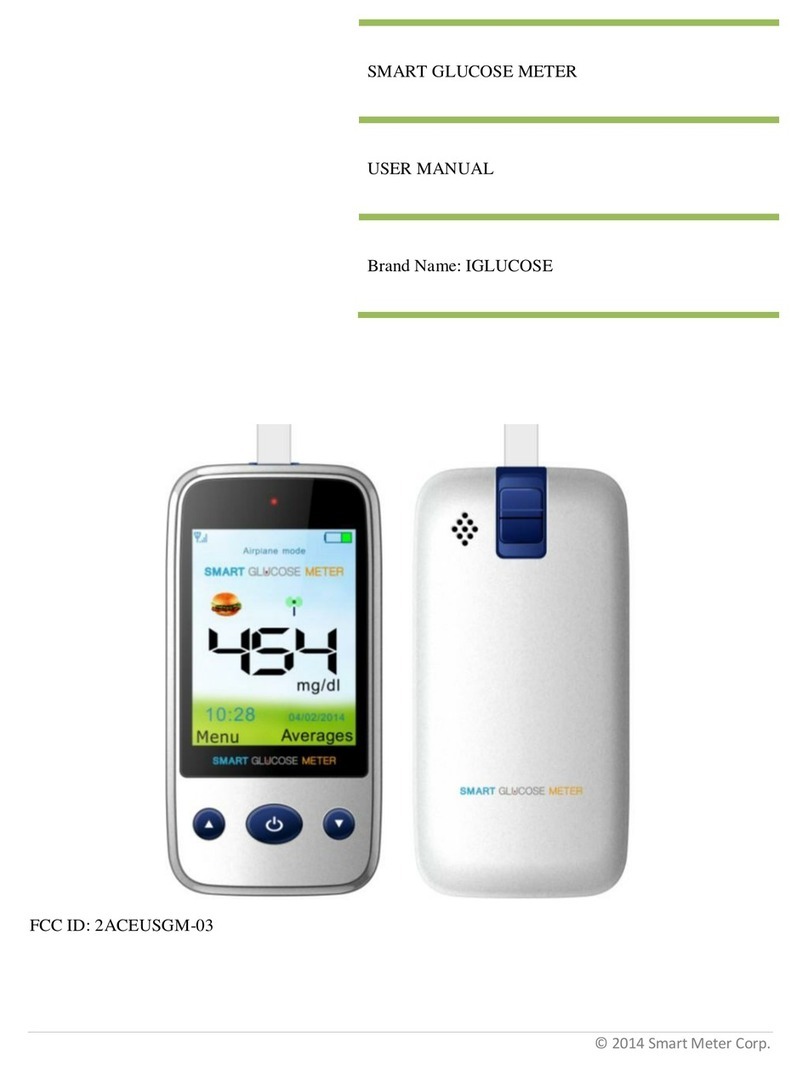
Smart Meter
Smart Meter iGlucose user manual
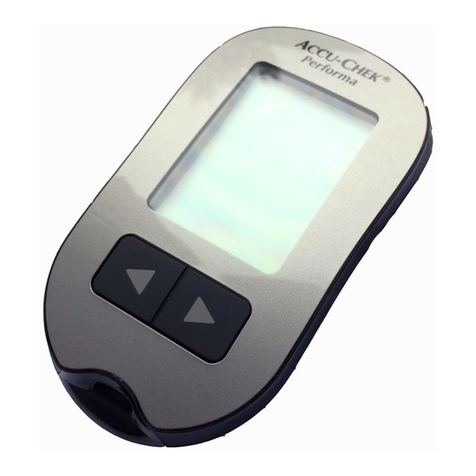
Roche
Roche Accu-chek Performa user manual
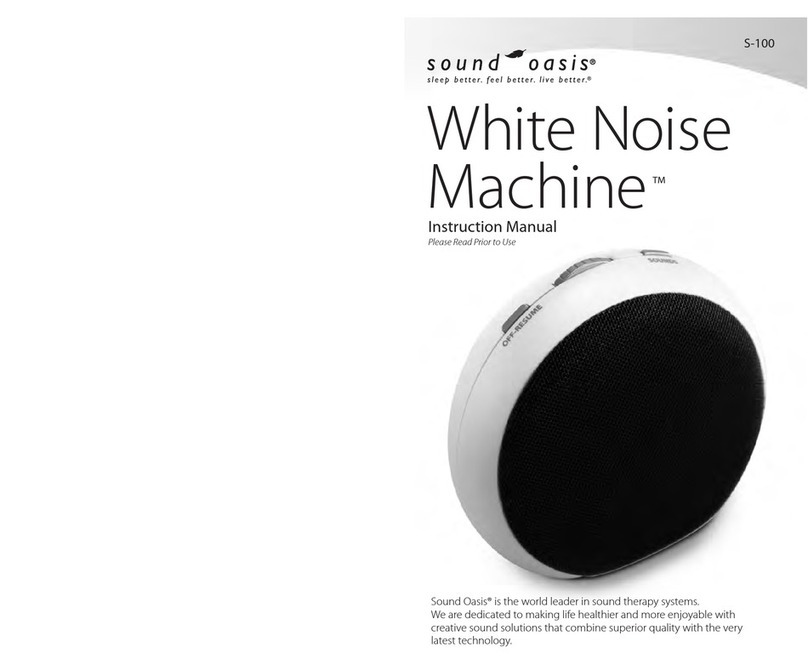
Sound Oasis
Sound Oasis White Noise Machine S-100 instruction manual

Bing Innovations
Bing Innovations DigiVibe owner's booklet
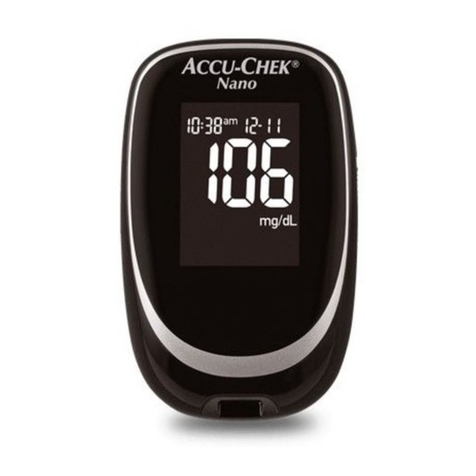
Accu-Chek
Accu-Chek Performa Nano owner's booklet

Accu-Chek
Accu-Chek Compact Plus owner's booklet
